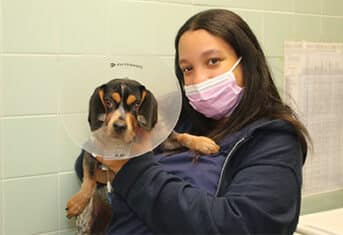How to Care for Your Pet’s Bandage

How to Care for Your Pet’s Bandage
Veterinarians at the Schwarzman Animal Medical Center bandage patient legs to hold intravenous catheters in place, immobilize a fracture so it can heal or to cover a wound to keep it clean. Bandages are essential medical devices, but like all devices, bandages require maintenance. Here’s how to ensure optimal outcomes for pets with bandages.
Swelling Above or Below the Bandage
Twice daily check the above and below the bandage for swelling. Swelling above the bandage indicates it is too tight. Swelling below the bandage, such as in the toes or the paw, can also indicate issues with the bandage. You should check in with your veterinarian if you notice swelling in either location.
Bandage Too Loose
Check the bandage position daily. If the toes disappear or the elbow or knee appears, the bandage is slipping down and can no longer do its job. Pay special attention if your dog is trying to shake the bandage off or pulls on the bandage with their teeth, as these behaviors may loosen the bandage and cause it to slide down the leg.
Wet, Smelly Bandage
If a bandage becomes wet, it can hold moisture against the skin, resulting in a serious infection and skin ulceration to develop out of your sight. In these instances, you may notice a bad smell emanating from the bandage. If you detect a bad smell coming from your pet’s bandage, it should be removed and replaced immediately. When walking your bandaged dog outdoors, use a heavy-duty plastic bag over the bandage to keep it dry. For long-term bandage management, consider a waterproof boot if your veterinarian approves. Remove the bag or boot immediately when you come back indoors as the bag will cause the bandage to be soggy.
Chewing the Bandage

When a dog chews at the bandage it gets wet, can come off or – in the recent case of a young dog cared for at AMC – can become its own medical emergency. The dog in question ate the bandage, which turned into an intestinal blockage requiring urgent surgery to remove. The dog is recovering well at home, but he is the poster child for the need for an Elizabethan collar when wearing a bandage. (For more information on e-collars, read our recent blogpost highlighting the necessity for the cone of shame.) Persistent bandage licking and chewing might indicate the bandage is uncomfortable and should be checked by your veterinarian.
Pain in the Bandaged Leg
If your pet is unwilling to walk on the bandaged leg or is crying when the bandage is touched, it may be a sign the bandage is too tight and it should be checked immediately.

































